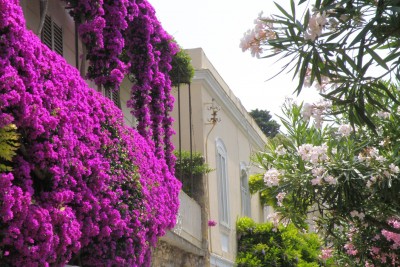Capri First Beguiles, Then Casts its Spell Upon You
You will feel happy, like many before, as you sense the spirit of the place



"For many weeks we looked across to Capri from the Sorrento hills. For many weeks we delayed our going, afraid to break the spell that seemed to hover over the island. No reality we felt could fulfill the promise of that elusive land which lay as if enchanted, now gleaming like an amethyst set in sunset gold, now lost in the haze of early morning. It was one of the islands of our fairy tales, we said, which would fade like a mirage before our bold approach. Perhaps it was to humor this whim that we took a "barca" at the little harbor of Sorrento one evening instead of crossing by the morning steamboat…
Across the bay of Naples was only a shimmering line light below the slope of Mount Vesuvius; behind us the moon laid a golden pathway back to the shore; before us stretched the calm sea and Capri loomed on our horizon…

We crossed the sea in silence and in silence passed into the real shadow of the real island, into the shadow, too, of past times, under the lee of the great cliff which falls sheer from the Tiberio, where peasants have danced for centuries above the ruins of the Ceasars' palaces...
We climbed the white road from the Marina to the top of the ridge which joins the heights of Monte Solaro and Anacapri at the north with that of Tiberio at the south — there we paused. Below us a white house, guarded by a stone pine, shone in the moonlight against the smooth sea, and Vesuvius rose beyond, purple through a luminous mist.
Such was the way of our coming, yet the morning did not lessen the wonder of that first impression and time only confirmed it. For since the days when the Emperor Augustus built his marble palace above the great sea-road where his Roman galleys passed homeward laden with Egyptian grain, down to our own time, Capri has given the seeker after beauty a satisfaction so perfect that it cannot be laid only to the brightness of its sun and the blueness of its water, but rather to that intangible, indefinable, but truly recognizable charm which we call " spirit of place," and which the artist has named "atmosphere."
Capri first beguiles, then casts its spell upon you. You are happy if you can yield to that spell and dream out your life on the island as many and many another has done, and happier if you can sense the spirit of the place, become subject to its inspiration, work with your might, and come away…

Nowhere out of the Orient can there be such wonderful effects. Such blazing sunsets on orange-tawny cliffs reflected in the sea; such water, turquoise-blue, peacock- blue, ultramarine, the blue of the Virgin's robe in Murillo's Prado pictures; such vivid living light, and such intense shadow.
Every season offers its especial feast of color. In the spring the little wood under San Michele flaunts armies of lavender crocus down the path beneath the chest-nut trees; the cliffs at Anacapri are fringed with fragrant narcisi; hillsides are a blow with vivid anemones, and these are the prelude to a burst of blossom — of peach, almond and cherry — which envelops the island in a mist of white and rose color. Then come the roses which last all summer, sheets of scarlet poppies, fields of pink and crimson clover and of yellow colza. Autumn gives you hillsides in the fullness of the vintage.
The island runs with the juice of the grape. Flat baskets piled high with white and purple bunches are borne through the vineyards on the heads of women, until in October, the vines robbed of their fruit turn to crimson and gold. That is to many the most beautiful time of the year in Capri.
But beyond all this splendor of color which dazzles one at first, Capri holds many phases of beauty less known. The beauty of the fading day, of after-sunset skies seen through quiet olive trees, of early evening along the wet sands of the Marina, of moonlight on cliff and houses.

At night, indeed, the island gains a simplicity and breadth of feeling which it lacks by day. The moonlight here holds an especially luminous quality of negative color, more entrancing in its subtlety than the positive effects of the sunshine. The silent cloisters and deserted courts of the old Carthusian monastery acquire an interest then which is wanting in daylight; so also do the narrow steep streets whose white walls sing out beyond the mystery of dark arched doorways…
At Anacapri both people and buildings show the influence of the later Moorish occupation. To hear them treading down the mud roof of a new house on a warm summer night, their feet keeping time to a weird reiterated cadence reminiscent of the East, is to believe oneself in Tunis… It is true that when the tourist comes the painter goes, and that there are many tourists in these days in Capri."
*Katharine Waldo Douglas, (1870-1939) was an American novelist and translator. Born in New York, she married first Francis Hunter in 1894 and later the artist Romilly Fedden, with whom she lived in Chantemesle, France. She wrote several books in the early 20th century, among them The Sign (1912), The Spare Room (1913), Shifting Sands (1914), The Rock (1915), The Basque Country (1921), and The Peacock's Tail (1925).
AmalfiCoasting choices of best websites on Capri:
www.nytimes.com/travel/guides/europe/italy/capri/overview.html
http://www.nytimes.com/2001/03/18/travel/finding-a-tranquil-side-of-capri.html
www.italia.it/en/media/virtual-tours
http://wikitravel.org/en/Capri
Watch a video


